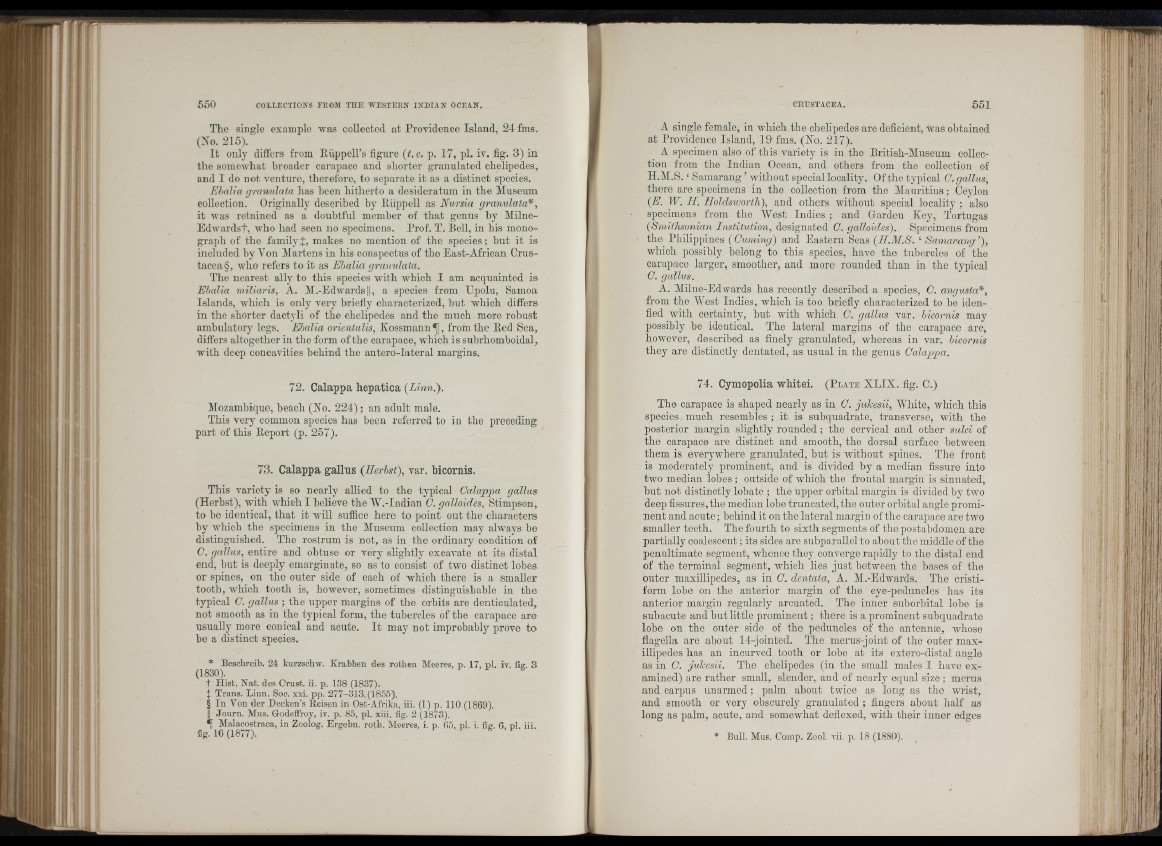
The single example was collected at Providence Island, 24 fms.
(No. 215).
I t only differs from Riippell’s figure (t. c. p. 17, pi. iv. fig. 3) in
the somewhat broader carapace and shorter granulated chelipedes,
and I do not venture, therefore, to separate it as a distinct species.
Ebalia granulata has been hitherto a desideratum in the Museum
collection. Originally described by lliippell as Nursia granulata*,
it was retained as a doubtful member of th at genus by Alilne-
Edwardst, who bad seen no specimens. Prof. T. Pell, in his monograph
of tho family], makes no mention of the species; but it is
included by Von Martens in his conspectus of tho East-African Crustacea
§, who refers to it as Ebalia granulata.
Tbe nearest ally to tbis species with which I am acquainted is
Ebalia miliaris, A. Al.-Edwards j|, a species from Upolu, Samoa
Islands, which is only very briefly characterized, but which differs
in tbe shorter dactyli of the cbelipcdes and tbe much more robust
ambulatory legs. Ebalia orientalis, Kossmann^, from tbe Eed Sea,
differs altogether in tbe form of tbe carapace, which is subrbomboidal,
witb deep concavities behind tbe antero-lateral margins.
72. Calappa hepática {Linn.).
Alozamhique, beach (No. 224); an adult male.
Tbis very common species has been referred to in tbe preceding
part of tbis Eeport (p. 257).
73. Calappa gallus (Herhst), var. bicornis,
Tbis variety is so nearly allied to tbe typical Calappa gallus
(Herbst), with wbicb I believe tbe W.-lndian C. galloides, Stimpson,
to be identical, th at it will suffice here to point out tbe characters
by which the specimens in tbe Alusenm collection may always be
distinguisbed. Tho rostrum is not, as in the ordinary condition of
C. gallus, entire and obtuse or very slightly excai'ate at its distal
end, but is deeply emarginate, so as to consist of two distinct lobes
or spines, on tbe outer side of each of which there is a smaller
tooth, wbicb tooth is, however, sometimes distinguishable in the
typical G. gallus ; the upper margins of the orbits are denticulated,
not smooth as in the typical form, tbe tubercles of the carapace are
usually more conical and acute. I t may not improbably prove to
be a distinct species.
* Beschreib. 24 kurzschw. Krabben des rothen Meeres, p. 17, pi. iv. fig 3
(1830). ^
t Hist. Nat. des Crust, ii. p. 138 (1837).
X Trans. Linn. Soc. xxi. pp. 277-313 (1855).
§ In Von der Decken’s Eeisen in Ost-Afrika, iii. (1) p. 110 (1869).
II Journ. Mus. Godeffroy, iv. p. 85, pi. xiii. fig. 2 (1873).
^ Malaeostraca, in Zoolog. Ergebn. rotb. Meeres, i. p. 65, pi. i. fig. 6, pi. iii.
fig. 16 (1877).
A single female, in wbicb the chelipedes are deficient, was obtained
at Providence Island, 19 fms. (No. 217).
A specimen also of this variety is in the Eritish-AIuseum collection
from the Indian Ocean, and others from the collection of
H.Al.S. ‘ Samarang ’ without special locality. Of the typical C. gallus,
there are specimens in tho collection from the Alauritius; Ceylon
(E. W. H. Holdsworth), and others without special locality; also
specimens from tbo West Indies ; and Garden Key, Tortugas
(Smithsonian Institution, designated C. galloides). Specimens from
the Philippines ( Cuming) and Eastern Seas (H.M.S. ‘ Samarang ’),
which possibly belong to tbis species, have tbo tubercles of tbe
carapace larger, smoother, and m.ore rounded than in tbe typical
C. gallus.
A. Alilne-Edwards has recently described a species, C. angusta*,
from the West Indies, wbicb is too briefly characterized to be iden-
fied Avitb certainty, but witb which C. gallus var. bicornis may
possibly be identical. The lateral margins of tbe carapace are,
bov'ever, described as finely granulated, whereas in var. bicornis
they are distinctly dentated, as usual in tbe genus Calappa.
74. Cymopolia whitei. (P late XLIX. fig. C.)
The carapace is shaped nearly as in C. jukesii, White, which this
species much resembles ; it is subqnadrate, transverse, witb tbe
posterior margin slightly rounded; tbe cervical and other sulci of
the carapace are distinct and smooth, tbe dorsal surface between
them is everywhere granulated, but is without spines. The front
is moderately prominent, and is divided by a median fissure into
two median lobes ; outside of wbicb tbe frontal margin is sinuated,
but not distinctly lobate ; the upper orbital margin is divided by two
deep fissures,tbe median lobe truncated, the outer orbital angle prominent
and acute; behind it on the lateral margin of the carapace are two
smaller teeth. Tbe fourth to sixth segments of tbe postahdomen are
partially coalescent; its sides are snbparallel to about the middle of the
penultimate segment, whence they converge rapidly to the distal end
of tbe terminal segment, which lies ju st between the bases of the
outer maxillipedes, as in C. dentata, A. Al.-Edwards. Tbe cristiform
lobe on the anterior margin of the eye-peduncles has its
anterior margin regularly arcuated. The inner suborbital lobe is
subacute and but little prominent; there is a prominent subqnadrate
lobe on the outer side of tbe peduncles of tbe antennse, whose
flagella are about 14-jointed. The merus-joint of tbe outer max-
illqiedes has an incurved tooth or lobo at its extero-distal angle
as in C. jukesii. Tbe chelipedes (in tbe small males I have examined)
are rather small, slender, and of nearly equal size; merus
and carpus unarmed; palm about twice as long as the wrist,
and smooth or very obscurelj’ granulated ; fingers about half as
long as palm, acute, and somewhat defiexed, witb their inner edges
i!
r
Ti il
In'